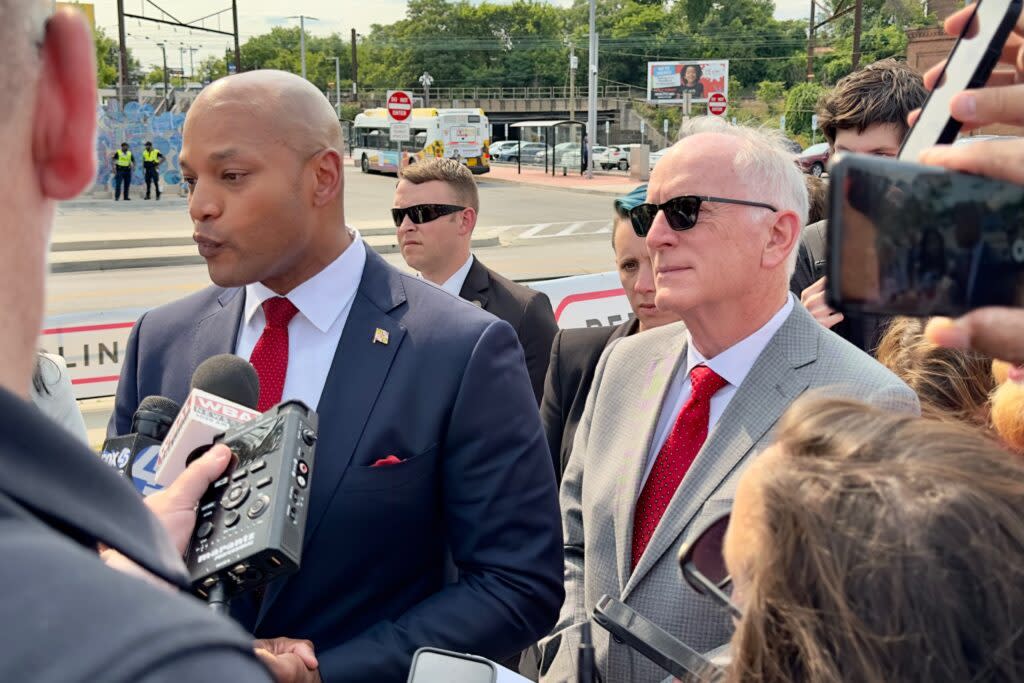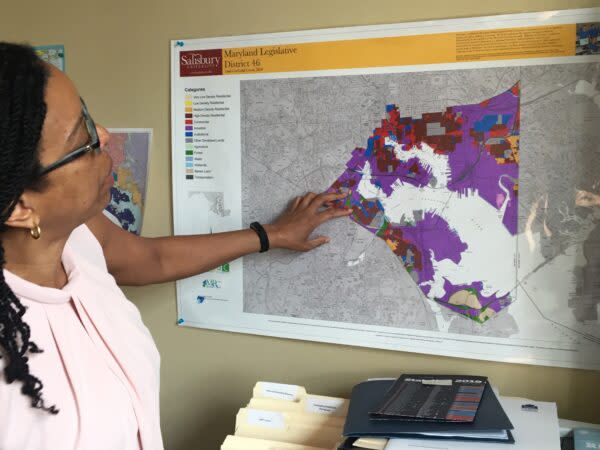Red Line announcement imminent; advocates say there’s no time to waste

Baltimore City Del. Robbyn T. Lewis (D-Baltimore City) had hoped she would be riding Baltimore’s Red Line Rapid Transit System by now.
Lewis, an unabashed transit advocate, likes to boast that she is the only state legislator who does not own a car. She remains bitter with the decision in 2015 by then-Gov. Larry Hogan to cancel the Red Line, a proposed light rail project that he called a “wasteful boondoggle.”
So Lewis was elated last June when Gov. Wes Moore announced plans to revive the Red Line. The proposed 14.1-mile system would run from the Centers for Medicare and Medicaid Services in Woodlawn, through downtown, Fells Point, Canton and end at Johns Hopkins Bayview Medical Center. Baltimore County Executive Johnny Olszewski Jr. is urging state officials to extend the line to Tradepoint Atlantic in Sparrows Point.
Since Moore’s announcement, state officials have been reviewing possible routes for the line, whether it should even be a rail line or instead be a dedicated bus rapid-transit lane, and how much of the line, if any, should be in underground tunnels.
Lewis expected the Maryland Department of Transportation to have already unveiled its choice of a mode and route for the rail line. A year later, no announcement has been made — but MDOT said it plans “a major announcement” Friday on the Red Line.
Red Line Project Director Allison Scott would only say this week that the department plans to announce whether light rail or bus rapid transit would be used to construct the east-west line. Details on the specific route, including options for building tunnels downtown, will not be announced until later this year, she said.
While she’s glad to hear about potential progress, Lewis notes that the delays are costly. Depending on which mode and route is selected, the ultimate price tag could exceed $7 billion.

“Whatever we do, we have to spend more money, and the longer the process takes, the more expensive it will become,” she said.
MDOT says it anticipates “a combination of local, state and federal funds will be utilized to construct the Red Line system.” At the state level, $100 million in funding through the Consolidated Transportation Program has already been allocated to carry the Red Line forward through planning.
One of the significant sources the Maryland Transit Administration plans to pursue is the Federal Transit Administration’s Capital Investment Grant program.
“The money for planning is there. Now the struggle is for construction,” Lewis said. “We need the actual drawings on paper, we need the plan, and we need the numbers. We need to know what the plan is going to cost.”
‘The people that need it the most’
Transit advocates say a substantial number of city residents depend on public transportation to get to and from their jobs. In many cases, those jobs are in the counties, so supporters of the Red Line say the east-west route must be integrated into a comprehensive plan to connect the existing light rail system and Baltimore Metro SubwayLink.
Chris Broughton, who lives in Canton, hopes Moore will identify enough state funding to ensure that there are no further delays in completing the project.
“If he’s serious about his campaign slogan ‘No one left behind,’ then funding the Red Line is exactly how he would show Baltimoreans and people surrounding it, that that actually means something,” Broughton said.
“The people that need it the most are the people that can’t afford a car or are most impacted by dirty air and dirty water,” he said.
Broughton favors the original design, which called for constructing tunnels under downtown streets, even though that option would be much more expensive.
“We’ve already dumped hundreds of millions of dollars into that project in the previous administrations, so if we start anew and select a new design, then we’re starting from day one, rather than starting from year five,” Broughton said.
Samuel Jordan, president of the Baltimore Transit Equity Coalition, said the state cannot afford any more delays in constructing the project.
“That is the most economically powerful project on the 25-year horizon, nothing else comes close,” Jordan said. “Once the Red Line is built, it will be the source of a continuous flow of taxable revenues that will last five to six decades.”
Looking at the price tag
But competition for transportation funding in Maryland is stiff. And while President Joe Biden has promised to fully fund the rebuilding of the Francis Scott Key Bridge, a project that could cost close to $2 billion, one legislator fears the state will have to absorb additional, unforeseen costs associated with the bridge collapse.
“Think about the preventive maintenance that we’re going to have to have on (Interstate) 895, 95 and the west side of 695,” said Sen. Johnny Ray Salling (R-Baltimore County), who represents the Dundalk area. “That’s going to be ongoing because of the truck traffic being rerouted and the millions of dollars for those areas, so there will be major infrastructure problems.”
To help address the huge transportation deficit, estimated at more than $2 billion, the General Assembly approved a series of tax and fee increases during the 2024 session. A large chunk of the revenue will go to the state’s Transportation Trust Fund.
But Lewis admits legislators will likely have to consider additional tax hikes in 2025 to help fund the Red Line and reduce the deficit.
“There’s going to be a big struggle to figure this out next session, and raising revenue again in 2025, it’s going to be a heavy lift, but we have to figure out how to do it,” she said.
SUPPORT NEWS YOU TRUST.
Despite the delays, however, Lewis remains optimistic about the Red Line.
“We’re not just considering extending a bus line up some street,” she said. “We’re talking about a regional network that takes people where they want to go. It connects them to jobs, connects them to education, health care, to recreation and entertainment.
“It’s going to take a few years. The city wasn’t destroyed overnight, it won’t come back to its glory overnight, but we’re on an upward trend and I’m glad to be part of it,” Lewis said.
The post Red Line announcement imminent; advocates say there’s no time to waste appeared first on Maryland Matters.

